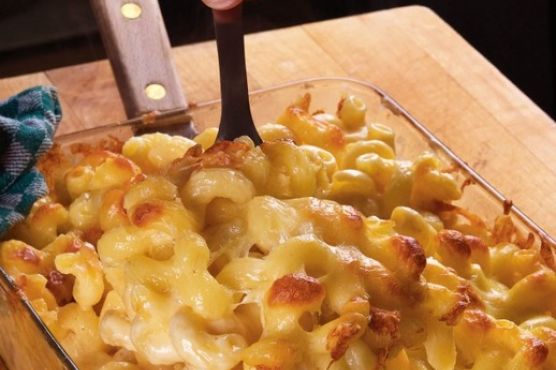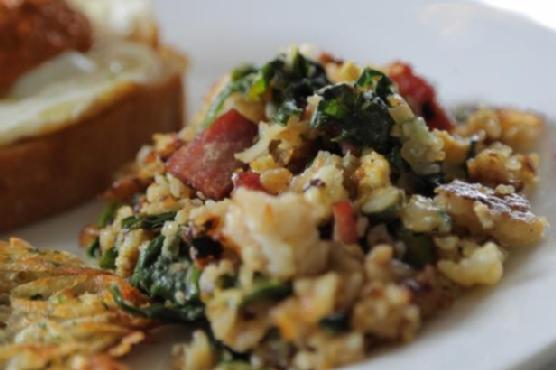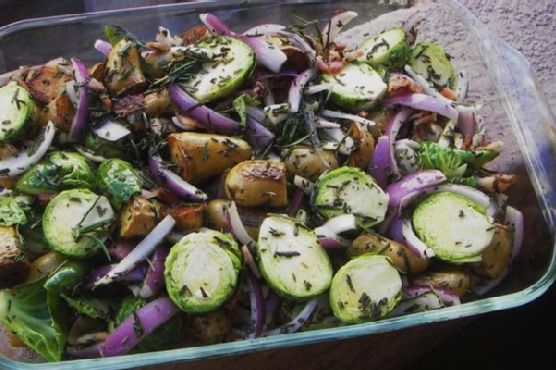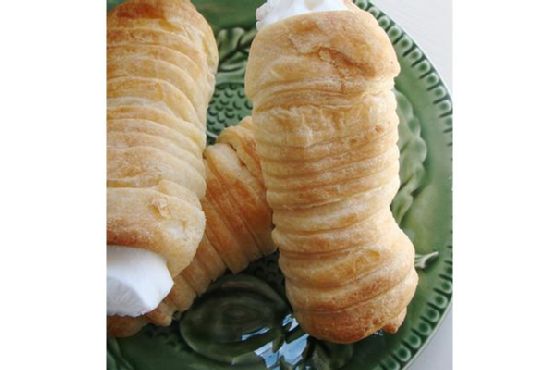Cook the Book: Mac and Cheese with Soubise
Cook the Book: Mac and Cheese with Soubise requires about 45 minutes from start to finish. For 66 cents per serving, this recipe covers 12% of your daily requirements of vitamins and minerals. One serving contains 368 calories, 13g of protein, and 10g of fat. This recipe serves 6. It is a very affordable recipe for fans of American food. 346 people were glad they tried this recipe. If you have flour, kosher salt, panko bread crumbs, and a few other ingredients on hand, you can make it. Plenty of people really liked this side dish. It is brought to you by Serious Eats. It is a good option if you're following a pescatarian diet. Overall, this recipe earns a solid spoonacular score of 53%. Try Cook the Book: Carroty Mac and Cheese, Cook the Book: Pimento Cheese, and Cook the Book: Cheese Bourekas for similar recipes.
Servings: 6
Ingredients:
1/4 teaspoon freshly ground black pepper
3 tablespoons butter, melted
1/4 teaspoon cayenne (optional)
1 to 2 teaspoons dry mustard
1 tablespoon fish sauce
3 tablespoons all-purpose flour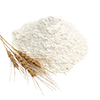
Kosher salt
12 ounces macaroni, penne, or cellentani
1 1/2 cups milk
1 medium onion, sliced
1/2 cup panko bread crumbs
1/4 cup grated Parmigiano-Reggiano, tossed with 2 tablespoons melted butter (optional)
1 shallot, roughly chopped
3 tablespoons sherry
1/4 teaspoon smoked paprika (optional, substitute cayenne if you wish)
1 tablespoon white wine vinegar.jpg)
Equipment:
frying pan
sauce pan
spatula
whisk
immersion blender
blender
baking pan
pot
bowl
oven
aluminum foil
broiler
grill
Cooking instruction summary:
Procedures 1 Make the Soubise: Melt half the butter in a medium pan over medium heat and add the onions and a four-fingered pinch of salt. Cook, stirring until the onions is nicely caramelized. 2 In a small saucepan over medium heat, melt the remaining butter. Add the shallot and a three-finger pinch of salt and cook until some of the water has cooked out of the butter, about 1 minute. Add the flour, stir to mix it with the butter, and cook until the mixture has taken on a toasted aroma, a few minutes. Gradually whisk in the milk and stir with a flat-edged wood spoon or spatula, to make sure the flour doesn’t stick to the bottom of the pan, until the sauce comes up to a simmer and thickens, a few minutes more. Stir in a three-finger pinch of salt, the white wine vinegar, sherry, fish sauce, dry mustard, black pepper, nutmeg, cayenne, and smoked paprika (if using). Add the onion to the sauce and stir until heated through. Transfer the sauce to a blender and process until puréed, or purée in the pan with a hand blender. Keep the sauce warm over low heat. You should have about 2 cups. 3 Cook the pasta just until al dente, drain, the return it to the pot. Use 1 tablespoon of the butter to spread on a 9-by-13-inch baking dish or another appropriately sized, ovenproof vessel. Place the pasta in a large bowl. 4 Sprinkle half of the Comté cheese into the soubise and stir until melted. Remove from the heat and pour over the pasta. Toss the pasta and pour it into the baking dish. Top with the remaining Comté. The pasta can be baked immediately or later in the day, or it can be covered and refrigerated for up to 3 days before baking. 5 Preheat the oven to 425°F. 6 Sprinkle the pasta with the Parmigiano-Reggiano (if using). In a small bowl, toss the panko with the remaining melted butter and spread this over the top. Cover with aluminum foil and bake until heated through, about 30 minutes (longer if it has been chilled in the refrigerator). Remove the foil and bake until the cheese is nicely browned, or turn on the broiler/grill and broil/grill until the top is browned, 15 to 20 more minutes. 7 Serve immediately.
Step by step:
1. Make the Soubise: Melt half the butter in a medium pan over medium heat and add the onions and a four-fingered pinch of salt. Cook, stirring until the onions is nicely caramelized.
2. In a small saucepan over medium heat, melt the remaining butter.
3. Add the shallot and a three-finger pinch of salt and cook until some of the water has cooked out of the butter, about 1 minute.
4. Add the flour, stir to mix it with the butter, and cook until the mixture has taken on a toasted aroma, a few minutes. Gradually whisk in the milk and stir with a flat-edged wood spoon or spatula, to make sure the flour doesn’t stick to the bottom of the pan, until the sauce comes up to a simmer and thickens, a few minutes more. Stir in a three-finger pinch of salt, the white wine vinegar, sherry, fish sauce, dry mustard, black pepper, nutmeg, cayenne, and smoked paprika (if using).
5. Add the onion to the sauce and stir until heated through.
6. Transfer the sauce to a blender and process until puréed, or purée in the pan with a hand blender. Keep the sauce warm over low heat. You should have about 2 cups.
7. Cook the pasta just until al dente, drain, the return it to the pot. Use 1 tablespoon of the butter to spread on a 9-by-13-inch baking dish or another appropriately sized, ovenproof vessel.
8. Place the pasta in a large bowl.
9. Sprinkle half of the Comté cheese into the soubise and stir until melted.
10. Remove from the heat and pour over the pasta. Toss the pasta and pour it into the baking dish. Top with the remaining Comté. The pasta can be baked immediately or later in the day, or it can be covered and refrigerated for up to 3 days before baking.
11. Preheat the oven to 425°F.
12. Sprinkle the pasta with the Parmigiano-Reggiano (if using). In a small bowl, toss the panko with the remaining melted butter and spread this over the top. Cover with aluminum foil and bake until heated through, about 30 minutes (longer if it has been chilled in the refrigerator).
13. Remove the foil and bake until the cheese is nicely browned, or turn on the broiler/grill and broil/grill until the top is browned, 15 to 20 more minutes.
14. Serve immediately.
Nutrition Information:
covered percent of daily need
